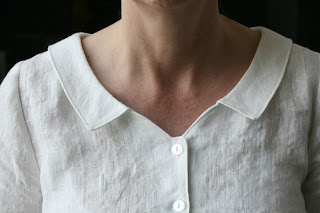So the new shirtdress did not get cut out Friday night. We are having unusually cool weather for July in Richmond, VA, and The Carpenter and I spend the evening on our back deck listening to the bird calls.
I awoke fresh on Saturday morning to begin my vintage shirtdress from the afore-mentioned "Lock and Key" fabric from Michael Miller. This was the 1962 pattern I had my eye on:
I was drawn to the pattern for two reasons: 1) it was a shirtdress (obviously), and 2) it was a half-size pattern. You can see it is a size 14 1/2 whose bust size is 35.
Erin is big on half size patterns, which seem to be patterns whose bust measurement is "halfway" between two sizes, and whose waist size is slightly larger in proportion than misses sizes. So, while a size 14 has a 34 bust, and a size 16 has a 36 bust, this 14 1/2 pattern is a 35 bust. Given that I am a middle aged woman, a little extra in the bust and waist would be welcome without having to make alterations to the pattern. I'm not entirely sure were I purchased this pattern, but I may have gotten it at Bygones in Carytown. (Sadly, Bygones underwent a renovation several years ago and the last time I was there they no longer carried vintage patterns.)
After spending the last few weeks pouring over the instructions, I decided to make the slim skirted version to test this pattern - less time, less fabric. But on Saturday morning, I pulled out the tissue pattern - still in factory folds - and found that the only pattern pieces inside the envelope were the four pattern pieces used to make the full skirt, and the pattern piece for the waist stay. No bodice pieces, no sleeves, no collar; basically, no pattern pieces that I needed. So, back to drawing board.
I went through my fairly extensive vintage pattern collection to try to find a shirtdress pattern that only needed three yards of fabric, and I chose this one, Simplicity 6584, from 1966:
I don't know where I got it, but it may have also been Bygones. The pattern was published in London, and you may notice that it is "suitable for uniforms":
For some, this designation might be a deterrent, but because I am such an enormous sewing geek, I was all over it. I can see nurses and waitress making this pattern in Britain for work in the 1960s. I decided to make View 2, which is the short sleeve version with the A-line skirt. Understandably, I was concerned about whether the pattern pieces were actually contained therein. Not all of them were; the pockets were missing and so was the sleeve cuff, the waist stay, and the belt. But thankfully all of the major pieces were there.
The pattern had been used before; the former owner had made the straight skirt version. In cutting out, I did a little creative layout so I could align all the pattern pieces in the same direction - it's my belief that all fabrics have a nap, and I avoid cutting out pieces "upside down". There's a little selvage in some of the seam allowances of my dress pieces, but I managed to get the entire dress cut out with the "with nap" layout.
I also decided to add the breast pocket, which I thought was really cute. The front pattern piece shows the full pocket layout, so all I had to do was trace it to replace the missing pocket pattern piece:
I didn't add seam allowances so my breast pocket is 1/2 inch smaller overall than what the pattern calls for, but I like it a little smaller anyway. After trying on the bodice, I added 1 inch to the waist by altering the side seams to 3/8 of an inch in the waist area.
So here it is with no buttons, no edgestitching, no sleeves and no hem:
I really like the breast pocket!
I like this pocket so much, I might have to add one of the skirt pockets to this dress from the scraps, to complete the retro vibe.
I tried this dress on, pinning the front closed, and it is surprising flattering, given that it is a "uniform". I'll probably add gray buttons. I am going to shorten the sleeves and eliminate the large cuff; I think I'll use the faux "cuff" a la The Hawthorn. Hopefully, I'll finish this one soon.
I always wonder about the prior owners of my vintage patterns - whether she was a nurse, or whether she used this pattern over and over, how old she was, etc. I wonder if she was peering over my shoulder as I cut this one out!










































